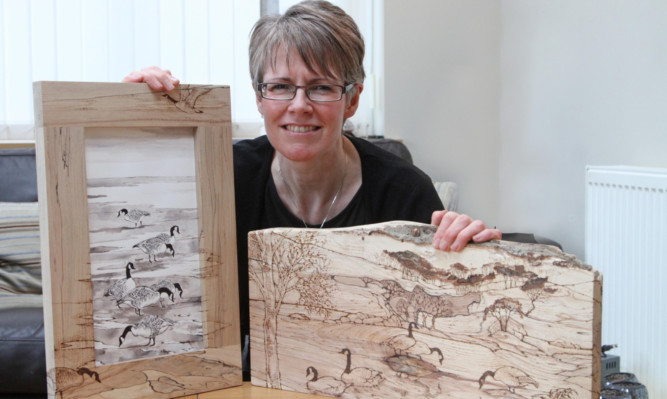Gail Duncan is no stranger to art.
The former Harris Academy pupil studied illustration and print making at Duncan of Jordanstone College in Dundee.
Apart from a seven year spell working for the DSS in Dundee, she has remained committed to art, now teaching the subject at Longforgan Primary where she has worked for 24 years.
But it was by “sheer chance” she fell into the world of pyrography – the art of decorating wood or other materials with burn marks resulting from the controlled application of a heated wire.
“For my 40th birthday my husband Garry didn’t know what to get,” explains the now 54-year-old mother-of-two at her home in Birkhill.
“He’s always been into wood he’s now a surveyor but trained as a joiner and seeing a pyrography machine advertised in one of the magazines he was looking at, thought ‘I’ll get that for Gail for her birthday’.
“I’d never heard of it but I went out and bought myself a bread board and sanded it down. The first time I put the wire into the wood I thought ‘I love this!’
“It’s the sensation of the wire cutting into the wood and the fine lines you get.”
At college, Gail specialised in etching, lino, and pen and ink type work.
But now she spends “just about every non-working moment” engrossed in the creation of intricate landscape, wildlife and commissioned work using her new-found pyrography talents.
She still uses the original pyrography equipment bought by her husband 14 years ago. Basically it comprises of a power pack with 10 settings attached to two prongs with a tiny wire strung between them. The ‘zero’ setting heats the wire to a point which allows her to engrave thin lines into wood. This can be varied up to 10 which gives the darkest lines and the most “burn”.
“It’s just so amazing because you get so much variation in line and tone,” she says, showing off a picture inspired by gannets she saw diving on a recent holiday to Arran.
“When I go back to pencil drawing I can’t get that huge variation from fine delicate lines right up to deep dark. It’s better than anything I’ve ever done. I feel more at home doing this than anything. I’ve always liked linear work, and when you follow the grain you get a lot of movement. “
Gail tends to use locally sourced Scottish hard woods for her work, mainly from a sawmill at Oakley near Dunfermline.
She adds: “Hardwood is more consistent and as it’s kiln dried it’s much more stable and better to work on. I predominately use elm and spalted beech. They have lots of interesting markings within their grain and are most suited to my style of work.
Gail works closely with Jim Brown, of ‘Woodcraft by Jim Brown’ at Kincaple, near St Andrews.
When the furniture maker buys wood, he keeps his eyes open for pieces of wood that might suit Gail.
They got to know each other through a table tennis club in Dundee.
Gail started off engraving some of his work and now does more elaborate illustrations for commissioned work.
She adds: “When I’m doing my own creations, then it is mostly landscapes and wildlife. But when I’m doing commissions people come to me with images they want. It might be a scene, a building or a landscape. I even did an oil rig in Russia for someone! I did a scene for a couple who lived on Seil Island for a lot of years. They came to me with a lot of images and I created a piece that went right around their hall.
“I also recreated a scene from the past when a client wanted a large piece of artwork depicting the waterfront at Newburgh when it was a busy port with a large Lino factory. We pieced together lots of old photographs and there were plenty of consultations and visits to Newburgh to ensure the scene captured the town as it was then.”
Gail laughs: “If I’m not teaching I’m burning!”. My husband says ‘have a day off!’ Actually, this is me having a day off because I just enjoy it so much!”
Gail and Jim are holding an exhibition at the Millennium Hall, Birkhill, on March 26/27.
https://www.facebook.com/Gail-Duncan-Pyrography-151367205221314/
